|
Displaying items by tag: Canvas
Rembrandt couldn’t decide whether to depict a rich man who commissioned a portrait standing up, or on his horse. And when he did determine how to show the wealthy gentleman, on horseback, he painted over the original image of the “sitter” standing up. Both portraits appear when the painting is x-rayed. Was canvas so expensive, or did Rembrandt not want a mere commissioned picture crowding out the personal works in his studio?
Nicolas Poussin admired the art of antiquity, which came down to him (and to us) mostly as sculpture. This may be why Poussin’s The Triumph of Pan seems like a sculptural frieze in paint, an odd paradox of permanence and perpetual movement.
Sotheby’s has announced that it will be selling Jasper Johns’s "Flag" (1983) during the November 11 Contemporary Art Evening Auction in New York. This particular example of "Flag," which is relatively small at approximately 11 x 17 inches and done in encaustic on silk and collaged onto canvas, carries a price estimate of $15 million to $20 million. (or about $1 million a square inch.) Before the sale, it will go on something of a grand tour, being showcased to collectors in Los Angeles, Hong Kong and London.
In 2010, Christie’s sold a larger version of a Johns flags, nearly 17 x 26 inches, which was also painted much early, circa 1960-1966, for a record price of $28.6 million.
Today's modern art forger is capable of producing fake works of art so perfect that even trained experts are unable to spot them. Even down to the most minute details of the pigments, binders, and canvas, these fakes are almost better than the works they're based on. But thanks to a byproduct of the Atomic age, the art world has a potent tool for finding forgeries.
Since the start of the 1960s, the art world—especially the modern art world—has been besieged by a torrent of faked "masterpieces." Peggy Guggenheim (yes, that Guggenheim) was once famously duped into purchasing what was believed to be a canvas painting by French artist Fernand Léger completed around 1913. It hung in her private collection for decades before being revealed as a forgery. This problem only expanded through the 1980s and 1990s as the market for modern art exploded.
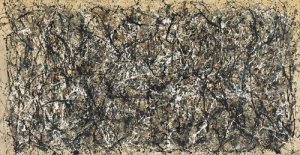
After a 10-month-long restoration, New York’s Museum of Modern Art has rehung Jackson Pollock’s (1912-1956) One – Number 31, 1950. The painting, which is considered one of the most significant works from the Abstract Expressionist movement, is also one of the finest examples of Pollock’s iconic drip paintings.
The restoration process, which began last July, involved feather dusting the canvas and the removal of decades of dirt that had left the painting with a yellow tinge. MoMA’s conservators used sponges, moist erasers, and cotton swabs to gently cleanse the massive canvas, which measures 9 feet high by 17 ½ feet wide. In addition to the cleaning, conservators closely studied the painting using X-ray and ultraviolet lights.
After thorough analysis of the canvas, conservators discovered that certain portions of One – Number 31, 1950 didn’t mesh with Pollock’s signature style. The sections were texturally unusual and contained different paint than the rest of the canvas. The discovery left conservators baffled as the painting hadn’t been touched since entering the MoMA’s collection 1968 and there was no record of a previous restoration.
It soon came to light that the painting had once belonged to Pollock’s friend, the art dealer Ben Heller, and that the work had been part of a traveling exhibition during the early 1960s. Researchers were able to locate a photo taken by a scholar in 1962 that showed the painting without any of the questionable areas, which meant that the painting was altered after 1962. After examining the canvas with ultraviolet light, conservators discovered tiny cracks under the paint’s surface, leading them to believe that the alteration was an attempt at a repair. Another shocking discovery that resulted from the high-tech analysis was that some of One – Number 31, 1950 was painted while the canvas was hanging on a wall, not laying on the ground as previously believed. The painting’s drips trickle downward, which would have been impossible to achieve if Pollock had created the entire work while standing above it.
The newly restored One – Number 31, 1950 is currently on view on the MoMA’s 4th floor.
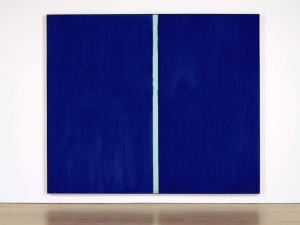
Sotheby’s evening sale of Contemporary Art, which took place on Tuesday, May 14, 2013 in New York, saw a number of exceptional works sell for record-breaking prices. The night’s top lot was Barnett Newman’s (1905-1970) Onement VI, an iconic Abstract Expressionist painting, which garnered $43.8 million. The work exceeded its high estimate of $40 million and set an auction record for Newman. The dark blue canvas, which measures 8 ½ feet x 10 feet and is sliced down the middle by a pale blue streak, is a remarkable example of Newman’s association with abstract expressionism as well as color field painting.
Other highlights from the sale included Gerhard Richter’s (b. 1932) oil painting of Milan’s cathedral square, Domplatz, Mailand (estimate: $30 million-$40 million), which sold for $37.1 million and set a record for Richter as well as for any living artist at auction; a sculpture by Yves Klein (1928-1962), which sold for $22 million and broke the record for the artist at auction; and Clyfford Still’s (1904-1980) PH-12, which was estimated to sell for $16 million to $20 million and ended up going for $20.9 million.
Although there were a number of high-profile sales, the auction was not without some failures. Francis Bacon’s (1909-1992) Study for Portrait of P.L., which was expected to bring $30 million $40 million didn’t find a buyer. Two works by Jeff Koons (b. 1955) also failed to sell.
The auction happenings will continue in New York at Christie’s, where Post-War and Contemporary sales will be held through the afternoon of Thursday, May 16, 2013.
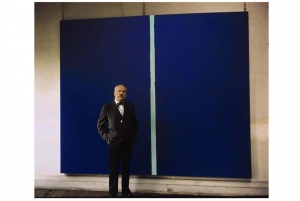
Sotheby’s Contemporary Art Evening Sale on May 14, 2013 in New York will include one of the most important paintings by Barnett Newman (1905-1970) ever to appear at auction. Onement VI (1953) is a seminal work by the American artist and one of the most significant pieces from the Abstract Expressionist movement. The painting, which measures 8 ½ feet x 10 feet, is expected to garner anywhere from $30 million to $40 million. The canvas will go on view at Sotheby’s on May 3, 2013 until it appears at auction later that month.
Newman, one of the foremost artists of the 20th century, was a pioneer of color field painting as well as a key Abstract Expressionist. As an exhibitions organizer at the Manhattan-based Betty Parsons Gallery in the 1940s, Newman played a fundamental role in the careers of many of his friends including Mark Rothko (1903-1970), Jackson Pollock (1912-1956), and Clyfford Still (1904-1980).
Onement VI, a massive canvas consumed by rich blue paint and sliced down the middle by a light blue streak, was a gift from the artist to his wife, Annalee. The painting remained in her collection for almost a decade and was acquired in 1961 by the well-known collectors Frederick and Marcia Weisman. That same year the painting appeared in an exhibition titled Abstract Expressionists Imagists at the Solomon R. Guggenheim Museum that helped define the modern art movement.
Onement VI is the final work in a series of six paintings by Newman. Four of the paintings are held in major art institutions including the Museum of Modern Art in New York, the Wadsworth Atheneum Museum of Art in Hartford, CT, and the Allen Memorial Art Museum in Oberlin, OH. Onement V currently resides in a private collection.
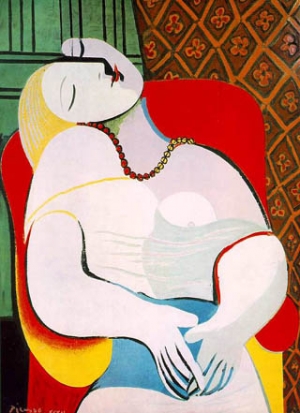
Steven Cohen, an American hedge fund manager and founder of SAC Capital Advisors LP, purchased Pablo Picasso’s (1881-1973) La Reve (1932) from casino tycoon Steve Wynn for $155 million. The sale marks the highest price paid by a U.S. collector for an artwork.
Cohen and Wynn have been in discussion about the sale since 2006. Originally, Wynn agreed to sell the painting to Cohen for $139 million but the transaction was cancelled after Wynn, whose vision is compromised, put his elbow through the canvas. The work has since been restored and the repair was factored into the selling price.
The sale comes less than two weeks after SAC Capital settled an ongoing insider trading case with the U.S. Securities and Exchange Commission for $600 million; it was the largest insider trading settlement in history. Cohen, who started collecting art in 2001, has an expansive collection that includes works by Vincent van Gogh (1853-1890), Edouard Manet (1832-1883), Willem de Kooning (1904-1997), Paul Cézanne (1839-1906), Andy Warhol (1928-1987), Jasper Johns (b. 1930), and Gerhard Richter (b. 1932).
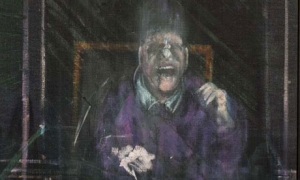
Six paintings by Francis Bacon (1902-1992) have been discovered on the backsides of amateur works by Lewis Todd (1925-2006), a former caricaturist for the Cambridge Daily News. Bacon preferred to paint on the unprimed backs of canvases because of their raw quality. While the Heffer Gallery of Cambridge supplied art materials to both Bacon and Todd, it is unclear how the canvases found their way to the gallery. Heffer often provided Todd with rejected canvases, which he cut up and used for his own impressionist compositions.
The six paintings appear to be part of Bacon’s “Pope” paintings, which he executed during the 1950s. The series depicts freeze-frames of eerie religious figures and includes some of Bacon’s best-known works. The Francis Bacon Authentication Committee has confirmed that five of the six works are genuine after paint sample tests revealed that the paint is the same paint Bacon used during the 1950s and 1960s.
The newly discover Bacon paintings will be sold at Ewbanks Auctions in southern England on March 20, 2013. A strong force in the art market, a previous sale of Bacon’s garbage, journals, and discarded artworks garnered nearly $1.5 million at Ewbanks in 2007. The auction house has a set a pre-sale estimate of $152,570 for the newly discovered paintings, but wouldn't be surprised if they fetched closer to $300,000.
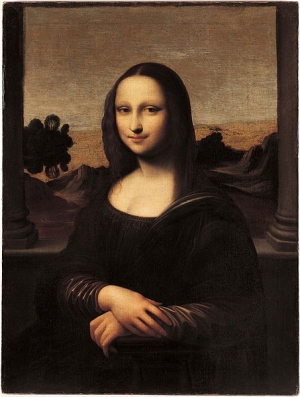
Recent tests on the Isleworth Mona Lisa support the theory that the painting pre-dates the Louvre’s world-famous portrait by Leonardo da Vinci (1452-1519). Hidden in a Swiss bank vault for 40 years, the Isleworth Mona Lisa was unveiled to the public on September 27, 2012, inciting rampant speculation about the work’s history. The Louvre’s Mona Lisa, which is believed to have been painted between 1503 and 1506, has been considered the only one of its kind for centuries.
The Swiss Federal Institute of Technology and Alfonso Rubino, a specialist in “sacred geometry,” carried out tests on the 15th century Isleworth portrait after its unveiling. Carbon dating determined that the canvas was manufactured between 1410 and 1455, shooting down claims that the Isleworth Mona Lisa was a late 16th century copy. Rubino’s geometric analysis also supported the da Vinci attribution, explaining that the geometry of the Isleworth portrait matched the geometry used by da Vinci in his other works including the Vitruvian Man (circa 1490).
The new findings combined with the existing scientific and physical research build a strong case for the Isleworth Mona Lisa. The Zurich-based Mona Lisa Foundation is even on board with the claim, vowing to pursue efforts to prove the portrait’s authenticity.
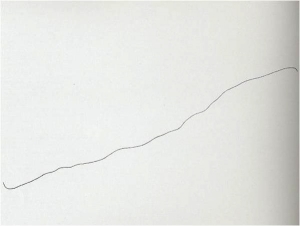
It was recently revealed that a Joan Miró (1893-1983) painting, which was damaged while on view at the Tate Modern in London, cost British taxpayers $326,000 to repair. Part of the museum’s retrospective of the Spanish modern artist, Painting on White Background for the Cell of a Recluse I (1968), was damaged when a visitor placed both hands against the work to steady himself after tripping and falling in the museum.
A white canvas sliced by a delicately wavering gray line, Cell of a Recluse I is one of five rare triptychs by Miró, which were exhibited together for the first time during the Tate retrospective in 2011. The work was immediately repaired after the incident, which left the acrylic on canvas painting with dents and markings. Cell of a Recluse I was on loan to the Tate from Barcelona’s Joan Miró Foundation and the British government paid the Foundation over $300,000 to cover the repair costs for the painting and to account for any loss in the work’s value due to the incident.
The Tate has recently been responsible for a string of damaged artworks including Mark Rothko’s (1903-1970) Black on Maroon (1958), which was defaced by a visitor, an early work by Roy Lichtenstein (1923-1977) titled Whaam! (1963), which was also marred by a museum patron, and a portrait of Margaret Thatcher by Helmut Newton (1920-2004), which was damaged when a staff member slipped and cracked the photograph’s glass frame.
|
|
|
|
|